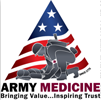Please contact your Administrator to change your authorization settings.
U.S. Army Medical Command
With the overseas contingency operations continuing, the spotlight justifiably is on the Army’s medics, evacuation units, surgical teams and field hospitals. Army Medicine is a seamless chain of care stretching back to fixed hospitals in Europe and the United States, where Soldiers receive state-of-the-art care. Field medical units are under the command of the combatant Commanders, because their movements and work must be coordinated with those of fighting forces.
In contrast, all fixed hospitals (in the U.S. and outside the U.S.)are commanded by the MEDCOM. The challenges for Army Medicine are (1) How to provide medical leadership for field units while respecting combatant Commander’s "ownership" and (2) How to integrate the work of field and fixed units.
Dual-hatted Surgeon/Commander
The AMEDD's answer is to "dual-hat" the top Army healthcare provider as both the Army Surgeon General and the Commanding General (CG) of MEDCOM.
The Surgeon General (TSG) serves as the medical expert on the Army staff, advising the Secretary of the Army, Army Chief of Staff and other Army leaders and providing guidance to field units. As Commanding General of the MEDCOM, the CG commands fixed hospitals and other AMEDD commands and agencies. This dual-hatted role unites in one leader's hands the duty to develop policy and budgets as TSG and the power to execute them as the MEDCOM Commander.
One Staff
This unity is reinforced by the "OneStaff" concept. This blends the Army surgeon general's staff, located in the Washington, D.C. area, and the MEDCOM commander's staff at Fort Sam Houston, Texas, into a single staff for both three-star functions.
Legally, the Office of the Surgeon General (OTSG) and MEDCOM remain separate entities with different duties and powers (for example, OTSG explains the medical budget to Congress; MEDCOM oversees its execution). However, staff members are now dual-hatted like TSG, to eliminate duplication and improve communication. The staff totals less than 1 percent of AMEDD strength. Three assistant surgeons general are dual-hatted as MEDCOM deputy chiefs of staff.
Other features of the Army Medicine structure:
- Medical research is unified under a single major subordinate command, U.S. Army Medical Research and Materiel Command (USAMRMC). USAMRMC includes six research laboratories and five other commands that focus on medical materiel advanced development, strategic and operational medical logistics, and medical research and development contracting;
- Eight Army medical centers, 27 medical department activities and numerous clinics in the United States, Europe, Korea, and Japan are grouped under five major subordinate commands called Regional Medical Commands (RMC);
- Dental facilities are grouped under the U.S. Army Dental Command (DENCOM), a major subordinate command. The DENCOM is organized into five regions called Regional Dental Commands (RDCs);
- The AMEDD Center & School (AMEDDC&S) is where the Army trains medical personnel, and also serves as a 'think tank,' with a mission to envision, design and train a premier military medical force for full-spectrum operations in support of our Country;
- The Warrior Transition Command (WTC) serves as the central comprehensive source for Warrior care support policy across the Army; and
- Preventive medicine, health promotion, and veterinary services at the central, regional, and district level are grouped under the U.S. Army Public Health Command.

